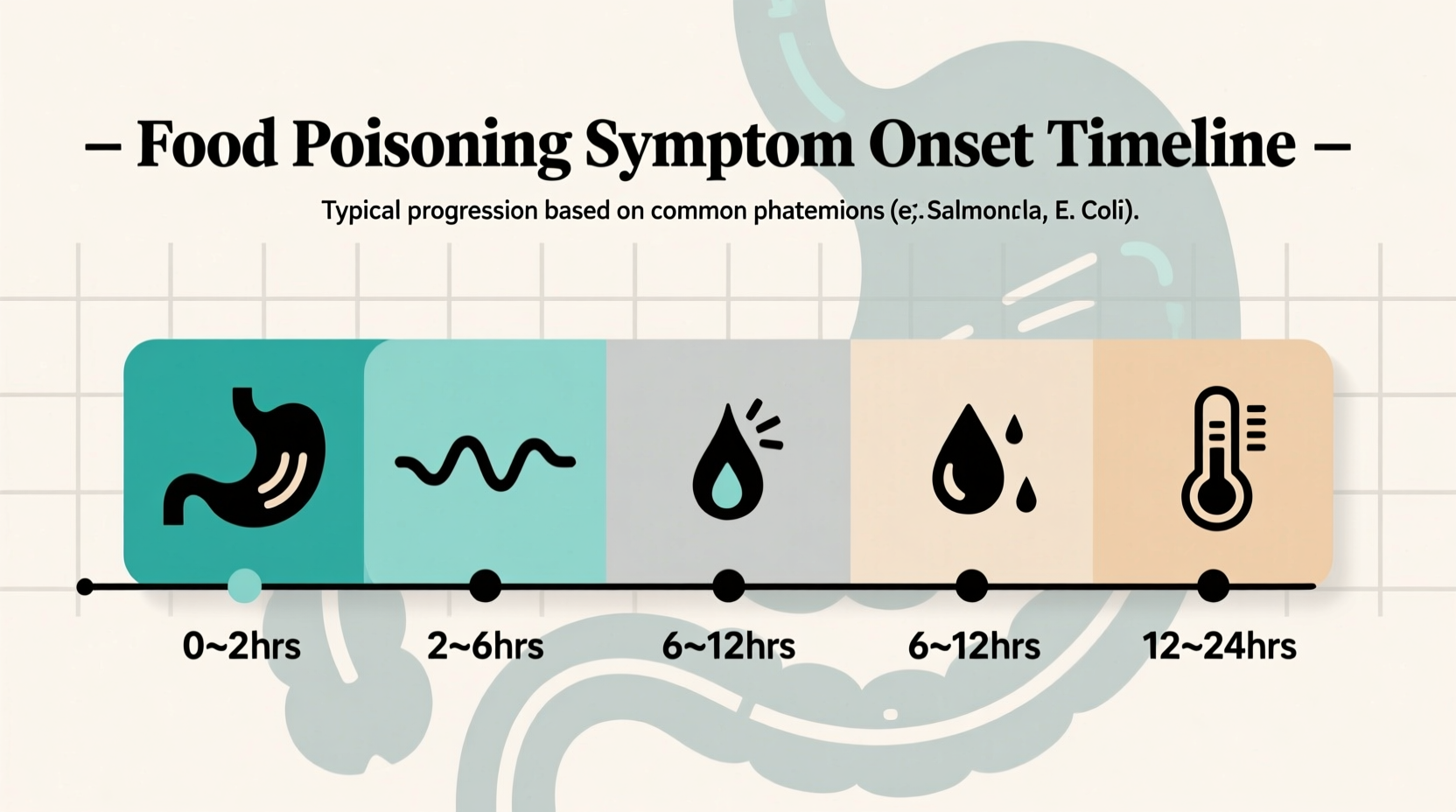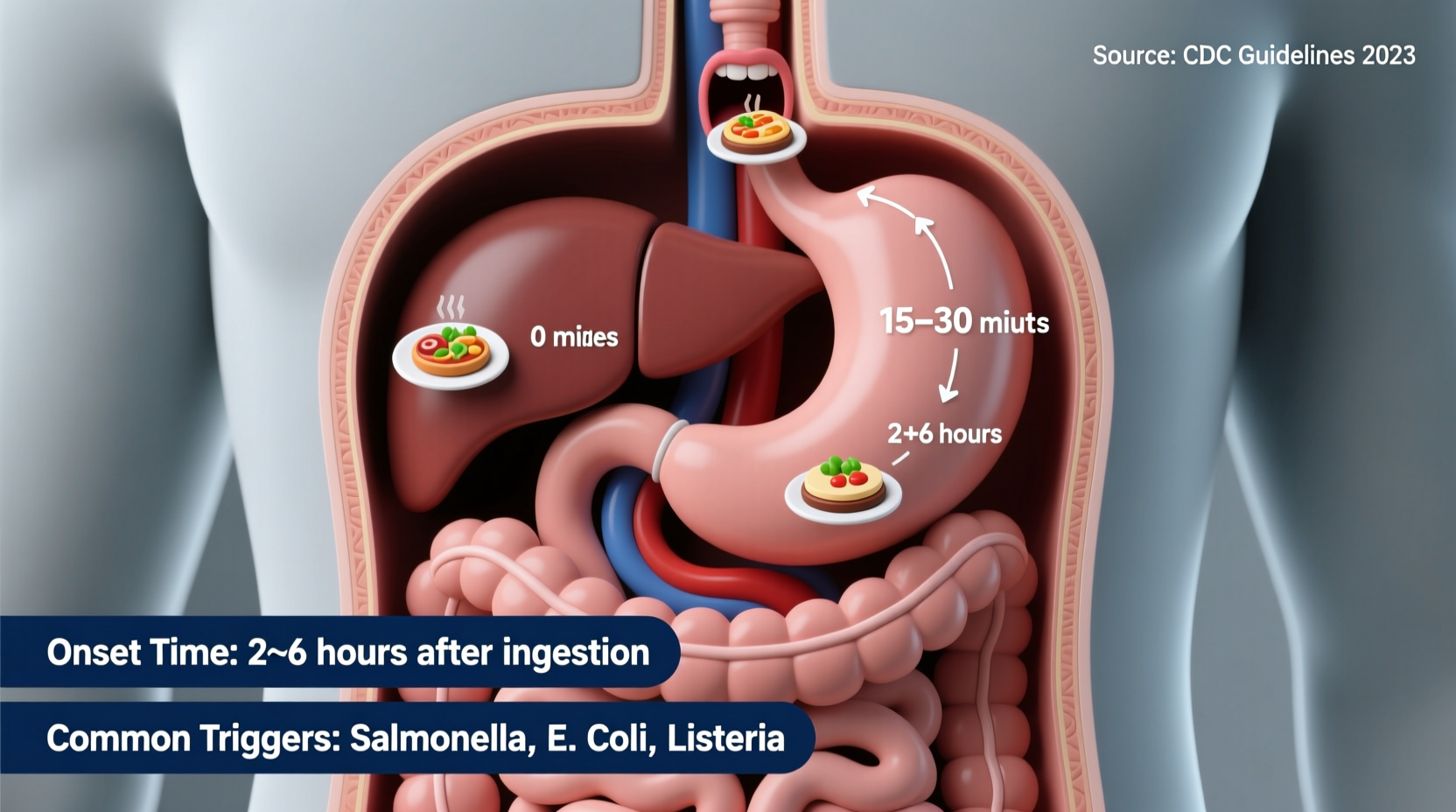Understanding exactly how long it takes to get food poisoning after eating is critical for proper response and treatment. Whether you're trying to identify the culprit meal or deciding whether to seek medical help, knowing these timelines could make all the difference in your recovery process.
Why Food Poisoning Timing Matters More Than You Think
When your stomach starts churning, your first question is usually "What did I eat that caused this?" Pinpointing the problematic meal isn't just about satisfying curiosity—it directly impacts your treatment options and helps prevent others from getting sick. The incubation period (time between consumption and symptoms) serves as a biological clock that can help identify the specific pathogen involved.
Food Poisoning Timeline: What Happens Inside Your Body
After consuming contaminated food, pathogens begin their journey through your digestive system. Some bacteria like Staphylococcus aureus release pre-formed toxins that cause almost immediate symptoms, while others like Salmonella need time to multiply in your intestines before making you sick. This biological process explains why food poisoning symptoms timeline varies so dramatically between different contaminants.
Pathogen-Specific Incubation Periods: Your Essential Reference
Not all foodborne illnesses follow the same schedule. The specific microorganism determines how quickly you'll feel symptoms. Here's what the CDC and FDA identify as typical onset times:
| Pathogen | Typical Onset Time | Common Sources | Duration of Illness |
|---|---|---|---|
| Norovirus | 12-48 hours | Raw produce, shellfish, contaminated water | 1-3 days |
| Salmonella | 6-6 hours | Poultry, eggs, unpasteurized milk | 4-7 days |
| E. coli (STEC) | 3-4 days | Undercooked beef, raw milk, contaminated produce | 5-10 days |
| Listeria | 1-4 weeks | Delicatessen meats, soft cheeses, unpasteurized dairy | Variable, can be severe |
| Campylobacter | 2-5 days | Raw poultry, unpasteurized milk | 2-10 days |
| Botulism | 18-36 hours | Improperly canned foods, fermented fish | Weeks to months |
This food poisoning incubation period chart comes directly from the Centers for Disease Control and Prevention's most recent surveillance data (CDC Food Safety Charts). Notice how dramatically the timelines vary—this explains why you can't rely on a single "standard" timeframe when trying to identify food poisoning.
4 Key Factors That Alter Food Poisoning Onset Time
Several variables can shorten or extend the typical how long after eating do food poisoning symptoms start timeline:
- Pathogen concentration - Higher levels of contamination often lead to faster symptom onset
- Individual immune status - Those with compromised immunity may experience delayed or more severe symptoms
- Food matrix - Fatty foods can slow gastric emptying, potentially delaying symptoms
- Concurrent medications - Antacids or proton pump inhibitors may alter stomach acidity, affecting pathogen survival
When to Seek Immediate Medical Attention
Certain symptoms require urgent care regardless of how long it takes to get sick from food poisoning. Contact a healthcare provider immediately if you experience:
- Signs of dehydration (extreme thirst, dry mouth, little or no urination)
- Diarrhea lasting more than 3 days
- Severe abdominal pain or rectal pain
- Neurological symptoms like blurred vision or muscle weakness (possible botulism)
- Bloody stools (common with E. coli infections)
The FDA emphasizes that certain foodborne illnesses become medical emergencies when specific symptoms appear, regardless of the typical incubation period.
What to Do While Waiting for Symptoms to Appear
If you suspect you've eaten contaminated food but haven't developed symptoms yet, follow these practical steps:
- Document everything - Write down exactly what you ate, when, and where
- Preserve evidence - If possible, save a sample of the suspected food
- Stay hydrated - Begin drinking electrolyte solutions before symptoms start
- Monitor closely - Note the exact time symptoms begin for medical reference
- Contact the source - Report suspected contamination to the restaurant or store
This proactive approach provides valuable information for healthcare providers and helps public health officials track potential outbreaks. The CDC's food poisoning symptom tracker shows that precise timing documentation significantly improves diagnosis accuracy.

Common Misconceptions About Food Poisoning Timing
Many people operate under incorrect assumptions about how long after eating do you get food poisoning. Let's clarify:
- Myth: "If I don't get sick within a few hours, I'm safe"
Reality: Some pathogens like Listeria have incubation periods up to 70 days - Myth: "Food poisoning always causes vomiting"
Reality: Some types primarily cause diarrhea without vomiting (like E. coli) - Myth: "If others ate the same food and feel fine, it's not contaminated"
Reality: Individual susceptibility varies widely based on immunity and stomach acidity
Preventing Future Incidents: Timing Your Food Safety Practices
Understanding food poisoning time frame isn't just about reaction—it's crucial for prevention. The FDA's Food Code specifies critical time limits for food safety:
- Perishable foods shouldn't remain in the "danger zone" (40°F-140°F) for more than 2 hours
- Refrigerate leftovers within 2 hours of cooking (1 hour if above 90°F)
- Cook poultry to 165°F, ground meats to 160°F, and fresh beef to 145°F to kill pathogens
These time and temperature guidelines directly correlate with pathogen growth rates. Following them significantly reduces your risk of experiencing how long does it take to get food poisoning after eating scenarios.
When Symptoms Don't Match the Timeline
Sometimes, what appears to be food poisoning might actually be something else. Conditions like appendicitis, gallstones, or viral gastroenteritis can mimic foodborne illness. If your symptoms:
- Appear outside typical incubation windows
- Include high fever (over 101.5°F)
- Feature severe, localized abdominal pain
- Persist beyond expected duration
Consult a healthcare provider for proper diagnosis. The American College of Gastroenterology notes that misdiagnosis of foodborne illness occurs in approximately 30% of gastrointestinal cases when patients rely solely on symptom timing.
Tracking Food Poisoning Outbreaks: The Bigger Picture
When you report suspected food poisoning with accurate timing information, you contribute to public health surveillance. The CDC's PulseNet system uses onset time data to:
- Identify outbreak patterns across geographical regions
- Determine likely contamination sources
- Implement timely recalls before more people get sick
Your precise documentation of how long after eating do food poisoning symptoms start could help prevent hundreds of additional cases.
How soon can food poisoning symptoms appear after eating contaminated food?
Symptoms can appear as quickly as 30 minutes with certain toxins like Staphylococcus aureus, but most common foodborne illnesses show symptoms between 6-72 hours after consumption. The exact timeframe depends entirely on the specific pathogen involved.
Can food poisoning take days to develop?
Yes, certain pathogens have longer incubation periods. E. coli typically shows symptoms in 3-4 days, hepatitis A can take 15-50 days, and Listeria may take up to 70 days to manifest. This delayed onset often makes identifying the source meal challenging.
What's the longest time it can take for food poisoning symptoms to appear?
Some foodborne illnesses have remarkably long incubation periods. Listeria can take up to 70 days, hepatitis A up to 50 days, and certain parasitic infections like cyclospora can take 7 days or more. This is why tracking all suspect meals over several weeks may be necessary.
Why do some people get food poisoning faster than others from the same meal?
Individual factors significantly impact onset time, including stomach acidity levels, immune status, existing gut microbiome, concurrent medications, and even stress levels. People with lower stomach acid (from medications like PPIs) often experience faster symptom onset.
If I ate something potentially contaminated but haven't gotten sick yet, am I safe?
Not necessarily. Some pathogens have incubation periods lasting weeks. Continue monitoring for symptoms for up to 70 days after exposure to certain contaminants like Listeria. Keep documentation of what you ate in case symptoms develop later.











 浙公网安备
33010002000092号
浙公网安备
33010002000092号 浙B2-20120091-4
浙B2-20120091-4